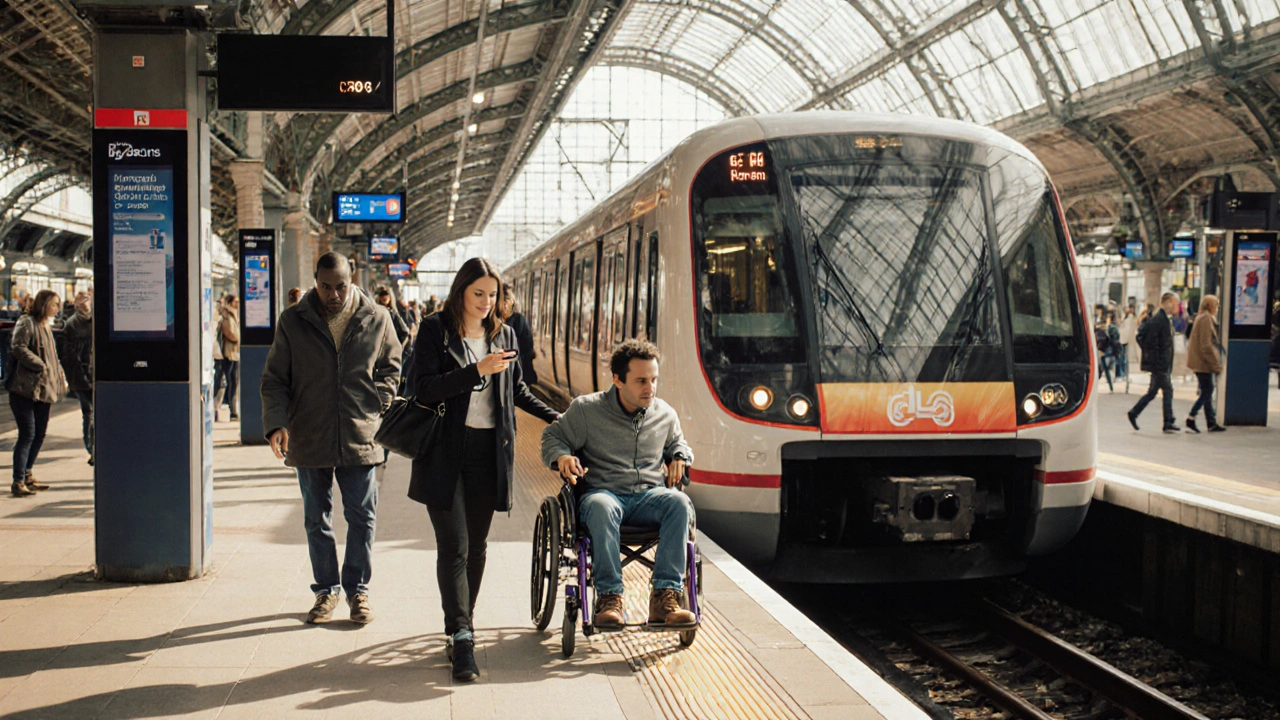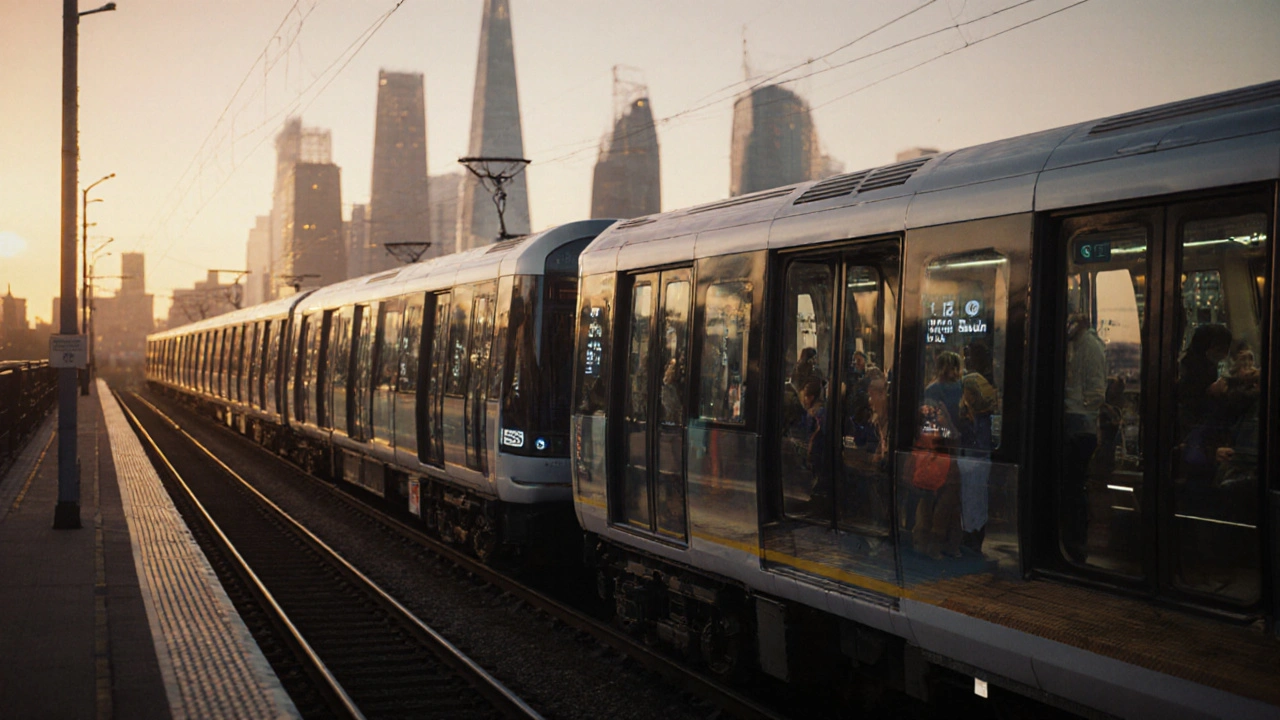When you step onto a DLR train in London, you might notice something strange: there’s no driver. No one behind the glass, no buttons to press, no announcements from a conductor. Just a quiet hum, a smooth ride, and a digital screen telling you the next stop. That’s because the DLR - the Docklands Light Railway - is one of the first fully automated metro systems in the world, and it’s been running like clockwork since 1987.
What Exactly Is the DLR?
The DLR isn’t a subway like the Tube. It’s a light rail system that runs mostly above ground, weaving through East London’s docklands, Canary Wharf, and out to places like Stratford, Lewisham, and Woolwich. It connects areas that used to be empty warehouses and abandoned docks into bustling neighborhoods full of offices, homes, and shops. Today, it carries over 100 million passengers a year - more than some entire national rail networks.
It was built to serve the redevelopment of London’s Docklands after the decline of the port industry in the 1980s. The government needed a cheap, fast way to move workers into the new financial district without building expensive underground tunnels. The solution? An automated, elevated rail system using modified metro trains and simple station designs.
How Does an Automated Train Work?
Automated trains like those on the DLR don’t need drivers because they rely on a mix of sensors, computers, and centralized control. Here’s how it works in practice:
- Automatic Train Control (ATC): Every train gets constant signals from the central control center about speed limits, next stops, and when to stop or go. Think of it like GPS for trains.
- Platform Edge Doors: At every station, doors on the platform sync exactly with the train doors. The train stops, the platform doors open, the train doors open - all automatically. No human needed.
- Onboard Monitors: Instead of a driver, you’ll see a screen showing the route, next stop, and safety messages. There’s also an emergency intercom if you need help.
- Remote Monitoring: Engineers watch all 110+ trains from a control room in Stratford. If something goes wrong - say, a door doesn’t close - they can pause the train remotely or send a technician.
It sounds high-tech, but it’s actually designed to be simple and reliable. No one’s trying to replace humans with robots - they’re just removing tasks that are repetitive and error-prone. A driver doesn’t need to watch for red lights or time stops perfectly. The system does it better.
Why Was the DLR Built This Way?
There were three big reasons the DLR went fully automated from day one:
- Cost: Hiring drivers for every train would’ve doubled the operating budget. With automation, one person can manage multiple trains at once.
- Frequency: Automated trains can run every 2-3 minutes during peak hours. That’s impossible with human drivers who need breaks, training, and shift changes.
- Reliability: Humans get tired. Machines don’t. The DLR has one of the highest on-time performance rates in London - over 95% in 2024.
It wasn’t perfect at first. Early riders complained about feeling unsafe without a driver. Some thought the trains would just zoom off into the Thames. But over time, riders got used to it. Now, most people don’t even think about it. The automation is invisible - and that’s the point.
What Makes the DLR Different From the London Underground?
Many tourists confuse the DLR with the Tube. They’re not the same. Here’s how they stack up:
| Feature | DLR | London Underground |
|---|---|---|
| Automation | Full automation since 1987 | Some lines automated (e.g., Victoria, Jubilee), most still have drivers |
| Track Type | Mostly elevated or at ground level | Mostly underground |
| Train Size | Smaller, 1-3 carriages | Larger, 6-8 carriages |
| Speed | Average 20 mph | Average 25 mph |
| Fare Zone | Zones 2-3 mostly | Zones 1-6 |
| Accessibility | 100% step-free access at all stations | Only about 70% of stations are step-free |
The DLR is slower than the Tube, but it’s cleaner, quieter, and easier to use. No cramped carriages. No need to squeeze into a packed train at 8 a.m. Most stations have real-time displays, ticket machines, and even free Wi-Fi. And because it’s automated, you can usually catch a train within a minute or two - even on weekends.
Where Does the DLR Go? Key Routes and Stations
If you’re visiting London, knowing where the DLR goes can save you time and money. Here are the most useful lines:
- Bank to Lewisham: Connects Canary Wharf to South London. Great for business travelers or anyone going to the O2 Arena.
- Stratford to Woolwich Arsenal: Links the 2012 Olympic Park to Royal Arsenal. Perfect for visitors heading to the Emirates Air Line cable car or the Thames Barrier.
- Beckton to Tower Gateway: Runs through the heart of East London. Stops at London City Airport - the only rail line that connects directly to an airport terminal.
- Bank to Canning Town: Connects to the Jubilee Line and the Emirates Air Line. One of the busiest interchange points.
DLR stations are easy to spot: they’re often modern, glass-and-steel structures with open platforms. You’ll find them near big developments like Canary Wharf, the ExCeL Centre, and the Royal Docks. Most stations have escalators, lifts, and tactile paving for the visually impaired - something the Tube still struggles with.
Is the DLR Safe Without a Driver?
Yes. And here’s why: the system has layers of safety checks.
- Trains can’t move unless all doors are closed and locked - sensors confirm this.
- Speed is limited by trackside signals. Even if someone tried to override it, the system won’t allow it.
- Emergency brakes are activated automatically if a train gets too close to another or if a platform door is opened while moving.
- There are CCTV cameras inside and outside every train, monitored 24/7.
- Station staff (called “customer service agents”) are present during peak hours to help and handle issues.
In over 35 years, there’s never been a fatal accident on the DLR. The system has been upgraded twice - in 2005 and 2018 - to handle more trains and improve reliability. In 2024, Transport for London reported just 0.3 incidents per million passenger journeys.

How Much Does It Cost to Ride the DLR?
The DLR uses the same fare system as the Tube: pay-as-you-go with an Oyster card or contactless payment. You’re charged based on zones and time of day.
- Peak fare (6:30-9:30 a.m., 4-7 p.m.): £3.20 (Zone 1-2), £3.80 (Zone 2-3)
- Off-peak fare: £2.70 (Zone 1-2), £3.20 (Zone 2-3)
- Daily cap: £8.50 for all zones - same as the Tube
It’s cheaper than driving. Parking in Canary Wharf costs £10-£15 an hour. A DLR ride from Canning Town to Bank takes 12 minutes and costs less than a coffee. For commuters, that’s a huge savings over time.
And because the DLR is fully integrated with London’s transport network, you can use the same card to switch between buses, Tube, Overground, and even river boats.
What’s Next for the DLR?
London is expanding the DLR. By 2027, new trains will be rolling out - longer, air-conditioned, with real-time digital displays and USB charging ports. The system is also getting new stations: one at Silvertown and another near the new Thames Estuary Airport (planned for 2030).
Future upgrades include AI-powered predictive maintenance - sensors on the tracks will alert engineers before a part fails. That means fewer delays and even better reliability.
There’s talk of extending the DLR to Barking, and even linking it to the Crossrail line. The goal? To make East London as connected as Central London - without the crowding.
Final Thoughts: Why the DLR Matters
The DLR isn’t just a train. It’s proof that automation can work in public transport - safely, affordably, and without losing the human touch. It transformed a forgotten part of London into one of its most valuable areas. It saved millions in operating costs. And it gave commuters a reliable, stress-free way to get around.
Most people don’t notice it. But if you’ve ever caught a DLR train at 7 a.m., stood in silence as the doors opened automatically, and arrived at your office without a single delay - you’ve experienced the future of transit. And it’s already here.
Is the DLR part of the London Underground?
No, the DLR is a separate light rail system. It’s operated by Transport for London but runs above ground, uses smaller trains, and is fully automated. You can use the same Oyster or contactless card, but it’s not technically part of the Tube network.
Can I use my contactless card on the DLR?
Yes. The DLR accepts contactless debit/credit cards, Apple Pay, Google Pay, and Oyster cards. Just tap in and out like you would on the Tube. There’s no need to buy a separate ticket.
Does the DLR run 24 hours?
No, the DLR doesn’t run 24/7. It usually starts around 5:30 a.m. and ends around 12:30 a.m. On Friday and Saturday nights, some lines offer a Night Tube service, but not all stations are served. Always check Transport for London’s website before late-night travel.
Is the DLR wheelchair accessible?
Yes. All 45 DLR stations have step-free access from street to platform. Elevators, tactile paving, and audio announcements are standard. Trains have wide doors and dedicated spaces for wheelchairs and buggies.
Why doesn’t the DLR have drivers if it’s so safe?
The DLR doesn’t need drivers because automation reduces human error, lowers costs, and allows for more frequent service. The system uses sensors, signals, and remote monitoring to ensure safety. Staff are still present at stations to assist passengers, but the trains themselves operate without on-board operators.
Can I take my bike on the DLR?
Yes, but only outside peak hours (6:30-9:30 a.m. and 4-7 p.m. on weekdays). Bikes are allowed on all trains, and most stations have bike racks. Folding bikes are allowed anytime.
If you’re visiting London and want to explore beyond the usual tourist spots, hop on the DLR. It’s cheap, quiet, and takes you to places you won’t find on a map - like the quiet canals of Millwall, the futuristic towers of Canary Wharf, or the historic warehouses turned art spaces in Royal Docks. You don’t need a driver to find the best parts of the city. Sometimes, all you need is a train that runs itself.
